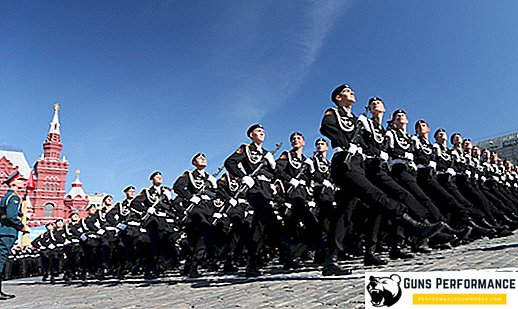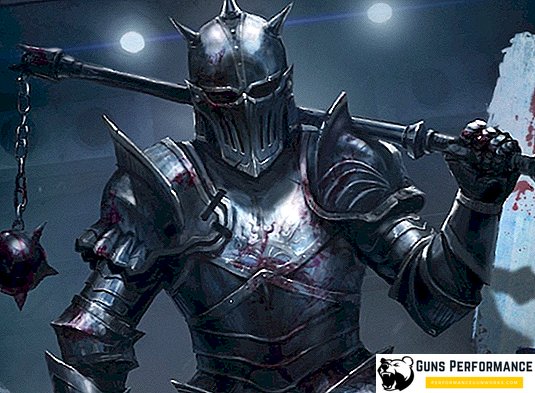
The ax, like a knife, has come a long way through the millennia with a man and still remains a very popular tool. The battle axes were practically revived after the Vietnam War (1964-1975) and are currently experiencing a new wave of popularity. The main secret of the ax lies in its versatility, although it is not very convenient to cut trees with a battle ax.
Parameters of battle axes
After watching films in which the horned Vikings swing enormous axes, many are left with the impression that the battle ax is something huge, terrifying by its very appearance. But the real battle axes differed from the workers just in their small size and increased shaft length. The battle ax weighed, as a rule, from 150 to 600 grams, and the length of the handle was about 80 centimeters. Such weapons could fight for hours without getting tired. The exception was the two-handed ax, the shape and size of which correspond to the impressive "cine" copies.
Types of battle axes

By types and forms of battle axes can be divided into:
- One-handed;
- Two-handed;
- Single-edged;
- Double-edged.
In addition, axes are divided into:
- Actually axes;
- Sekira;
- Chekana;
- Halberds.
Each of these species has many subspecies and variations, however, the main division looks exactly like this.
Most ancient battle ax
The history of the ax began in the Stone Age. As is known, the stick and the stone became the first instruments of labor for man. The stick evolved into a club or a bludgeon, a stone into a sharp hack, which is the progenitor of the ax. It was possible to cut the loot with a chopper or chop the branch. Even then, the progenitor of an ax was used in tribal clashes, as evidenced by finds of fractured skulls.
The turning point in the history of the ax was the invention of the method of connecting a stick with a chopper. Such a simple design increased the impact power several times. At first, the stone was tied to the handle with vines or veins of animals, which gave an extremely unreliable connection, although it was enough for several blows of an ax. The shape of the stone ax was already then reminiscent of modern. Fighting skirmishes demanded reliable weapons, and gradually the axes began to grind and fasten to the handle through a hole drilled in the stone. The manufacture of a high-quality ax required long and painstaking work, so skillfully made axes were used mainly in clashes with enemies. Already in that era there was a division into battle axes and workers.

Bronze Age Axes
The heyday of the era of bronze axes occurred in ancient Greece. At first the battle ax of the Hellenes was stone, but with the development of metallurgy, battle axes were made of bronze. Along with the bronze, stone axes were also used for a long time. Greek axes for the first time began to make double-edged. The most famous Greek ax with two blades is Labrys.

The images of the Labris are often found on ancient Greek vases, and are held in the hands of the supreme god of the Greek pantheon Zeus. The finds of huge Labrys during excavations of the Cretan palaces testify to the cult and symbolic use of these axes. Labrys were divided into two groups:
- Cult and ceremonial;
- War Labris.
Everything is clear with cult ones: because of their enormous size, they simply could not be used in skirmishes. Combat Labrys size copied the usual combat ax (a small ax on a long handle), only the blades were located on both sides. We can say that these are two axes united into one. The complexity of manufacturing has made such an ax an attribute of the leaders and great warriors. Most likely this served as a further ritualization of the Labris. To use it in battle, the warrior had to possess considerable strength and dexterity. Labrys could be used as a two-handed weapon, because two blades allowed to strike, without expanding the shaft. In this case, the warrior had to dodge enemy strikes, and any entry of the Labris was usually fatal.
The use of labris paired with a shield required tremendous skill and strength in the hands (although labrisses for this were made individually and were smaller). Such a warrior was practically invincible and in the eyes of others was the epitome of a hero or god.
Barbarians axes of the era of ancient Rome

During the rule of ancient Rome, the main weapon of the barbarian tribes was also an ax. Among the barbaric tribes of Europe there was no hard division into classes, every man was a warrior, a hunter and a farmer. Axes were used both in everyday life and in war. However, there was in those days a very specific ax - Francis, which was used only for combat.
When confronted on the battlefield with the barbarians armed by the Francis, for the first time, the invincible legionnaires initially suffered defeat after defeat (however, the Roman military school quickly developed new ways of defense). The barbarians threw their axes at the legionnaires with great force, and being at close range they chopped them at tremendous speed. As it turned out, the Francis of the barbarians were of two types:
- Throwing, with a shorter grip, which is often tied with a long rope, which allows to pull the weapon back;
- Francis for melee, which was used as a two-handed or one-handed weapon.
This division was not rigid and, if necessary, the “ordinary” Francis could be thrown no worse than the “special” one.
The very name of "Francis" recalls that this battle ax was used by the Germanic tribe of Franks. Each warrior had several axes, and Francis for close combat was a treasured weapon and the pride of his master. Numerous excavations of the burials of rich warriors testify to the high value of these weapons for the owner.
Viking battle ax

The ancient Viking battle axes were a terrible weapon of that era and were associated precisely with sea thieves. The one-handed axes had many forms that were not very different from each other, but the Brodex two-handed ax was remembered by the enemies of the Vikings for a long time. The main difference between brodeax is a wide blade. With such a width it is difficult to talk about the universality of the ax, but he chopped off the limbs with one blow. In that era, the armor was leather or chain mail, and the wide blade perfectly cut through them.
There were also one-handed brodeksy, but the so-called "Danish ax" was exactly two-handed and could not be better suited for foot and tall Scandinavian pirates. Why did the ax become the symbol of the Vikings? The Scandinavians did not go to the “Vikings” for their prey because of the incredible steepness, they were forced to do so by the harsh natural conditions and the barren lands. Where do poor farmers have money for swords? But the ax was in the household of each. After re-forging the blade, all that was needed was to put the ax on a long strong handle, and the terrible Viking was ready for the march. After successful campaigns, the warriors acquired good armor and weapons (including swords), but the ax remained the favorite weapon of many fighters, especially since they owned them masterly.
Battle axes of the Slavs

The form of the battle axes of ancient Russia practically did not differ from the one-handed axes of Scandinavia. Since Russia had close ties with Scandinavia, the Russian battle ax was also Scandinavian twin brother. Pedestrian Russian troops and especially the militia used battle axes as their main weapon.

Russia also maintained close ties with the East, from which came a specific battle-hatchet - the gavel. Looks like a hatchet and it. It is often possible to find information that chisel and hammer are one weapon - but, despite their external similarity, these are completely different axes. The gavel has a narrow blade that cuts through the target, while the topping of the shape resembles a beak and pierces the target. If you can use a metal of the best quality for the manufacture of a dam, then the narrow edge of the chisel must withstand considerable loads. Rus’s battle warrior was the weapon of the horsemen who had adopted this weapon from the horse-drawn steppe dwellers. Often the mints were richly decorated with precious inlays and served as insignia of the military elite.

In later times, the battle ax in Russia served as the main weapon of predatory sleeves and was a symbol of peasant revolts (along with fighting scythes).
Ax - the main competitor of the sword
For many centuries, the battle ax did not yield to positions of such specialized weapons as the sword. The development of metallurgy made it possible to massively manufacture swords intended solely for combat functions. Despite this, axes did not yield to positions, and judging by the excavations, they even led. Consider why an ax as a universal tool could compete on equal terms with a sword:
- The high cost of the sword compared with the ax;
- The ax was in any household and fit for battle after a minor alteration;
- For an ax, the use of quality metal is optional.
All these factors allowed the ax to maintain its leading position. Of course, the rich and professional warriors had swords, but there were few of them in any country of that era.
Modern battle axes

Currently, many firms make so-called "tactical" tomahawks or battle axes. Especially advertised are the products of the company "SOG" with their flagship model M48. The axes have a very spectacular "predatory" appearance and various options for the butt (hammer, hammer or second blade). These devices are more designed for combat than for economic use. Such tomahawks are not recommended to throw because of the plastic handle: they fall apart after a few blows to the tree. In the hand, this device is also not very comfortable and constantly tries to turn, because of which the blow can turn out to be sliding or even flat. It is better to make a battle ax by yourself or with the help of a blacksmith. Such a product will be reliable and made by your hand.
Making a battle ax
In order to make a battle ax, you will need an ordinary economic ax (preferably made by the USSR from the time of Stalin), a template and a grinder with a grinder. According to the template, we cut the blade and give the desired shape to the ax. After that, the ax sits on a long handle. Everything, the battle ax is ready!
If you want to get a quality battle ax, you can forge it yourself or order a blacksmith. In this case, you can select the steel grade and be completely confident in the quality of the finished product.
The history of battle axes has more than a dozen of millennia, and although in the modern world there are only a few models left for combat use, many have an ordinary ax at home or in the country, which can be turned into battlefield without much effort.












